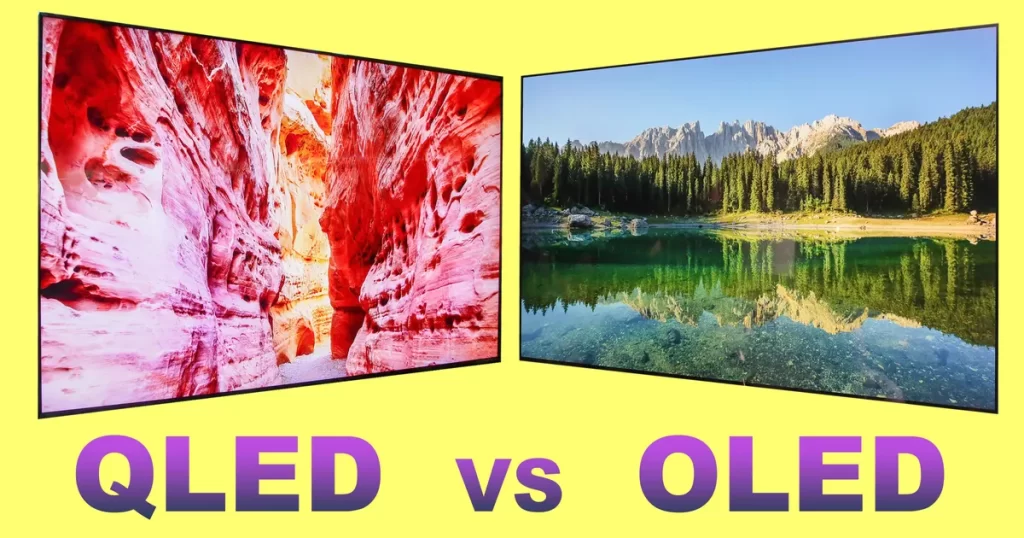Unlocking the Magic of Modern TV Technology
Modern TVs offer an array of advanced technologies that make watching TV an immersive and enjoyable experience. In this guide, we’ll take a closer look at the most popular TV technologies and what makes them stand out.

Screen Technologies
When it comes to screen technologies, there are several different types available, including OLED, QD-OLED, LCD, and LED. While they may all seem the same at first glance, each type of screen has its own unique features and benefits.
- Screen Technologies: The screen is the heart of any TV, and there are several different types of screen technologies available. Here’s a breakdown of the most popular ones:
- LCD (Liquid Crystal Display): LCD screens are the most common type of screen used in modern TVs, including LED TVs. They’re affordable and offer excellent color accuracy, making them a popular choice for budget-friendly TVs. However, they have limited viewing angles and can’t produce deep blacks.
- LED (Light Emitting Diode): LED TVs use LED backlighting to illuminate the screen, which is still an LCD panel. They offer better contrast, deeper blacks, and a wider color gamut than standard LCD TVs, making them ideal for watching movies and playing video games. LED TVs are also energy-efficient and produce less heat than LCD TVs. However, they can be more expensive than LCD TVs, and some models suffer from blooming (light bleed) and uniformity issues.
- OLED (Organic Light Emitting Diode): OLED TVs use organic compounds to create light, resulting in perfect blacks, infinite contrast, and stunning color accuracy. OLED screens can produce deeper blacks and brighter whites than any other type of screen, making them ideal for watching movies and TV shows with dark scenes. OLED screens are also more flexible than other screen technologies and can be made curved or even rollable. This technology is quite different from QLED, despite the similar acronym. OLED screens have the advantage of pixel level light control, resulting in incredible contrast and more accurate colors compared to QLED, which use a filter to achieve improved color accuracy. While earlier OLED models had a reputation for burn-in (image retention), newer OLED models have largely resolved this issue with technologies like pixel shifting. However, OLED screens can still have a shorter lifespan than LCD and LED screens.
- QLED (Quantum Dot Light Emitting Diode): QLED TVs use quantum dots to create light, resulting in brighter and more vivid colors. QLED screens use LED backlighting to create light, which means that they are still technically an LCD screen with a quantum dot layer. They’re similar to OLED TVs but aren’t quite as good when it comes to contrast. QLED screens are more affordable than OLED screens and offer excellent color accuracy. However, they can suffer from blooming and have limited viewing angles.
- QD-OLED (Quantum Dot OLED): QD-OLED is a new type of screen technology that combines the best of both worlds – the pixel-level light control of OLED and the color accuracy of QLED. QD-OLED screens use quantum dots to enhance color accuracy, and OLED technology to deliver perfect blacks and infinite contrast. These screens are relatively new, and we can expect to see more models released in the coming years.
Sound Technologies
The sound quality of modern TVs has improved dramatically in recent years, with many TVs boasting advanced sound technologies.
- Dolby Atmos is an advanced sound technology that uses object-based audio to create a 3D sound experience. It delivers a more immersive sound quality that makes you feel like you’re in the middle of the action.
- DTS:X is another object-based audio technology that delivers a 3D sound experience. It’s similar to Dolby Atmos but isn’t quite as widely used.
- Virtual surround sound is a technology that simulates the effect of surround sound using just two speakers. It’s not as immersive as Dolby Atmos or DTS:X, but it’s still a significant improvement over standard stereo sound.
Software Technologies
Modern TVs also come with advanced software technologies that offer a range of features and functionalities.
- Smart TVs are internet-enabled TVs that offer access to a variety of streaming services like Netflix, Amazon Prime, and Hulu. They also come with features like social media apps, and voice control.
- Voice control technology allows you to control your TV using your voice. It’s a convenient feature that makes it easy to change channels, adjust the volume, and search for content.
- High Dynamic Range (HDR) is a technology that enhances the contrast and color accuracy of a TV screen. It delivers more vibrant and lifelike images and is ideal for watching movies and TV shows with bright or dark scenes.
- Many modern TVs come with advanced gaming features like low input lag, variable refresh rates, and gaming modes. These features are ideal for gamers and can improve the overall gaming experience.
In conclusion, modern TVs offer a range of advanced technologies that make watching TV an immersive and enjoyable experience. OLED and QD-OLED screens stand out as the best in terms of contrast, color accuracy, and flexibility. While there are many different types of sound and software technologies to choose from, Dolby Atmos and DTS:X offer an immersive audio experience that takes your viewing experience to the next level. Virtual surround sound is a more affordable option that still offers a significant improvement over standard stereo sound. Smart TVs, voice control, HDR, and gaming features are just a few examples of the many software technologies available that enhance your TV viewing experience. Whether you’re on a budget or looking to splurge, there’s a TV technology that’s right for you
References:
- Gagnon, M. (2021). OLED TV vs. QLED TV: What’s the Difference? Lifewire. https://www.lifewire.com/oled-tv-vs-qled-tv-4167708
- LG OLED TVs. (n.d.). LG USA. https://www.lg.com/us/oled-tvs
- Samsung QLED TVs. (n.d.). Samsung US. https://www.samsung.com/us/televisions-home-theater/tvs/qled-tvs/
- What is Dolby Atmos? (n.d.). Dolby Laboratories. https://www.dolby.com/about/support/guide/dolby-atmos-guide/
- What is QD-OLED? (n.d.). CNET. https://www.cnet.com/tech/home-entertainment/what-is-qd-oled-samsungs-new-tv-tech-explained/

